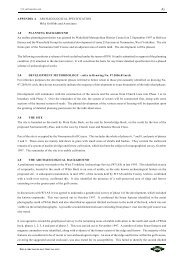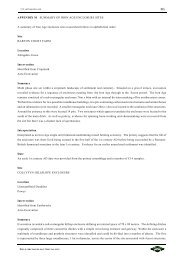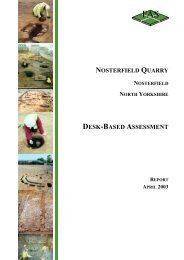ARCHAEOLOGICAL EVALUATION - Mike Griffiths and Associates
ARCHAEOLOGICAL EVALUATION - Mike Griffiths and Associates
ARCHAEOLOGICAL EVALUATION - Mike Griffiths and Associates
Create successful ePaper yourself
Turn your PDF publications into a flip-book with our unique Google optimized e-Paper software.
FAS_lbf01.wpd 104<br />
from this deposit but a flint flake as well as a small piece of Langdale greenstone were found. The flint<br />
fragment displays a small area of polishing <strong>and</strong> may represent a knapped piece from a polished stone axe. F16<br />
was interpreted as a small pit.<br />
F17 was situated c.0.40 to the east of F16 <strong>and</strong> appeared as a small sub-circular deposit of mid-greyish-brown<br />
silty s<strong>and</strong> measuring c.0.48m in diameter. The feature was half-sectioned approximately east-west, where it<br />
proved to be 0.15m deep <strong>and</strong> backfilled with a single deposit (C1196). A flint flake <strong>and</strong> Neolithic pottery were<br />
recovered from C1196 during excavation <strong>and</strong> following recording, the remaining half was excavated to recover<br />
any further material <strong>and</strong> the full form of the feature. C1196 consisted of a silty s<strong>and</strong> <strong>and</strong> contained rare mixed<br />
moderate gravel <strong>and</strong> charcoal flecks. A small assemblage of poorly preserved ceramic was recovered during<br />
excavation, <strong>and</strong> assessment identified two vessels of probable later Neolithic date. In addition, two flint flakes<br />
were recovered. F17 was interpreted as a small truncated pit.<br />
F18 was situated c.48.00m from the southern end of the<br />
intervention <strong>and</strong> appeared as a large possible circular pit located<br />
against the eastern limit of excavation <strong>and</strong> continuing beyond it<br />
(Plate 26). The feature measured c.4.40m in diameter <strong>and</strong> was<br />
half-sectioned where it proved to have gently sloping sides to a<br />
depth of c.0.80m, whereafter the sides became near vertical<br />
(Figure 60). The feature was excavated to a depth of 1.20m<br />
below the top of ploughsoil; excavation was not taken beyond<br />
this depth for health <strong>and</strong> safety reasons.<br />
Plate 26 F18, Intervention 23, looking east<br />
(scale 1m)<br />
F18 proved to be filled with at least four distinct deposits up to a depth of 0.90m. The earliest excavated fill<br />
of F18 consisted of a coarse s<strong>and</strong>y clayey silt with high percentages of mixed gravel (70%) (C1195). The<br />
deposit was excavated to reveal a minimum thickness of 0.20m, but the base was not found. This fill was<br />
overlain by C1194 made of a clayey s<strong>and</strong>y silt with rare mixed gravel (4%), which measured 0.35m thick <strong>and</strong><br />
was ‘u’-shaped in profile. C1194 was overlain by C1193, an unusual deposit of marl which was pale brown in<br />
colour <strong>and</strong> contained only traces of fine gravel <strong>and</strong> pebbles but was otherwise sterile. The deposit was welldefined<br />
against underlying C1194, measured 0.30m thick <strong>and</strong> was ‘u’-shaped in profile, overlying C1192.<br />
C1192 represented the latest fill of F18 <strong>and</strong> consisted of a stiff dark brown s<strong>and</strong>y silt containing rare mixed<br />
gravel <strong>and</strong> pebbles (4%) measuring up to 0.45m thick. Modern glass <strong>and</strong> china were recovered from C1192<br />
during excavation as well as a sherd of North Yorkshire Gritty ware <strong>and</strong> a flint end scraper, a fragment of flint<br />
core, a chert flake which had been utilised, <strong>and</strong> four flint flakes. F18 has been interpreted as a sink hole <strong>and</strong><br />
corresponds with F13 (Intervention 17) <strong>and</strong> F28 (Intervention 4).<br />
F19 was situated 19.20m from the southern limit of the intervention <strong>and</strong> appeared as a sub-circular feature<br />
positioned against the western limit of intervention <strong>and</strong> disappearing beneath it. Where visible, the feature<br />
measured 5.60m long x 3.20m wide. The southeastern quadrant of the feature was excavated where it proved<br />
to be a steep-sided feature filled with three distinct deposits, C1205, C1206 <strong>and</strong> C1227 (Figure 61). C1227 was<br />
the basal fill of the feature <strong>and</strong> consisted of a deposit of gravel-rich sterile brown silt. This deposit was overlain<br />
by C1206 which was an homogenous brown sterile clayey-silt with frequent mixed gravel <strong>and</strong> pebble inclusions.<br />
The final fill of F19 was allocated C1205 which was a deposit of brown sterile clayey silt with frequent mixed<br />
FIELD ARCHAEOLOGY SPECIALISTS







